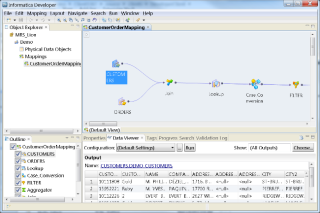Cómo instalar Thelia 2.3 en CentOS 7
¿Usando un sistema diferente? Thelia es una herramienta de código abierto para crear sitios web de comercio electrónico y administrar contenido en línea, escrito en PHP. Código fuente de Thelia i
Anchor CMS is a super-simple and extremely lightweight, free and open source Content Management System (CMS) Blog Engine that supports editing content in Markdown or HTML, and is fully i18n compatible out of the box. Creating and modifying themes is as easy as writing some very simple PHP and HTML/CSS, so there are no new templating languages to learn. Anchor CMS weighs in at only 250KB (compressed) so it is the perfect solution for web developers and bloggers who are tired of bloatware and just want a simple and minimalist blogging engine that gets the job done without any extra complications.
In this tutorial we are going to install Anchor CMS on a Fedora 26 LAMP VPS using Apache web server, PHP 7.1, and a MariaDB database.
We will start by adding a new sudo user.
First, log into your server as root:
ssh root@YOUR_VULTR_IP_ADDRESS
Add a new user called user1 (or your preferred username):
useradd user1
Next, set the password for the user1 user:
passwd user1
When prompted, enter a secure and memorable password.
Now check the /etc/sudoers file to make sure that the sudoers group is enabled:
visudo
Look for a section like this:
%wheel ALL=(ALL) ALL
Make sure it is uncommented. This line tells us that users who are members of the wheel group can use the sudo command to gain root privileges.
Once you have edited the file, you can save and exit by pressing Esc and then entering :wq to "write" and "quit" the file.
Next we need to add user1 to the wheel group:
usermod -aG wheel user1
We can verify the user1 group membership and check that the usermod command worked with the groups command:
groups user1
Now use the su command to switch to the new sudo user user1 account:
su - user1
The command prompt will update to indicate that you are now logged into the user1 account. You can verify this with the whoami command:
whoami
Now restart the sshd service so that you can login via ssh with the new non-root sudo user account you have just created:
sudo systemctl restart sshd
Exit the user1 account:
exit
Exit the root account (which will disconnect your ssh session):
exit
You can now ssh into the server instance from your local host using the new non-root sudo user user1 account:
ssh user1@YOUR_VULTR_IP_ADDRESS
If you want to execute sudo without having to type a password every time, then open the /etc/sudoers file again, using visudo:
sudo visudo
Edit the section for the wheel group so that it looks like this:
%wheel ALL=(ALL) NOPASSWD: ALL
Please note: Disabling the password requirement for the sudo user is not a recommended practice, but it is included here as it can make server configuration much more convenient and less frustrating, especially during longer systems administration sessions. If you are concerned about the security implications, you can always revert the configuration change to the original after you finish your administration tasks.
Whenever you want to log into the root user account from within the sudo user account, you can use one of the following commands:
sudo -i
sudo su -
You can exit the root account and return back to your sudo user account any time by simply typing the following:
exit
Before installing any packages on the Fedora server instance, we will first update the system.
Make sure you are logged in to the server using a non-root sudo user and run the following command:
sudo dnf -y update
Install the Apache web server:
sudo dnf -y install httpd
Then use the systemctl command to start and enable Apache to execute automatically at boot time:
sudo systemctl enable httpd
sudo systemctl start httpd
Check your Apache configuration file to ensure that the DocumentRoot directive points to the correct directory:
sudo vi /etc/httpd/conf/httpd.conf
The DocumentRoot configuration option will look like this:
DocumentRoot "/var/www/html"
Now, let's make sure that the mod_rewrite Apache module is loaded. We can do this by searching the Apache base modules configuration file for the term "mod_rewrite".
Open the file:
sudo vi /etc/httpd/conf.modules.d/00-base.conf
Search for the term mod_rewrite.
If the mod_rewrite Apache module is loaded, you will find a configuration line looking like this:
LoadModule rewrite_module modules/mod_rewrite.so
If the above line starts with a semi-colon, you will need to remove the semi-colon to uncomment the line and load the module. This, of course, applies to any other required Apache modules too.
We now need to edit Apache's default configuration file so that mod_rewrite will work correctly with Anchor CMS.
Open the file:
sudo vi /etc/httpd/conf/httpd.conf
Then find the section that starts with <Directory "/var/www/html"> and change AllowOverride none to AllowOverride All. The end result (with all comments removed) will look something like this:
<Directory "/var/www/html">
Options Indexes FollowSymLinks
AllowOverride All
Require all granted
</Directory>
Now save and close the Apache configuration file.
We will restart Apache at the end of this tutorial, but restarting Apache regularly during installation and configuration is certainly a good habit, so let's do it now:
sudo systemctl restart httpd
We now need to open the default HTTP and HTTPS ports as they will be blocked by firewalld by default.
Open the firewall ports:
sudo firewall-cmd --permanent --add-port=80/tcp
sudo firewall-cmd --permanent --add-port=443/tcp
Reload the firewall to apply the changes:
sudo firewall-cmd --reload
You will see the word success displayed in your terminal after each successful firewall configuration command.
We can quickly verify that the Apache HTTP port is open by visiting the IP address or domain of the server instance in a browser:
http://YOUR_VULTR_IP_ADDRESS/
You will see the default Apache web page in your browser.
SELinux stands for "Security Enhanced Linux". It is a security enhancement to Linux which allows users and administrators more control over access control. It is enabled by default in Fedora 26, but it is definitely not essential for server security as many Linux server distributions do not ship with it installed or enabled by default.
To avoid file permission problems with Anchor CMS later down the line, we are going to disable SELinux, for now. Open the SELinux configuration file with your favourite terminal editor:
sudo vi /etc/selinux/config
Change SELINUX=enforcing to SELINUX=disabled and then save the file.
To apply the configuration change, SELinux requires a server reboot, so you can either restart the server using the Vultr control panel or you can simply use the shutdown command:
sudo shutdown -r now
When the server reboots, your SSH session will get disconnected and you may see a message informing you about a 'broken pipe' or 'Connection closed by remote host'. This is nothing to worry about, simply wait for 20 seconds or so and then SSH back in again (with your own username and domain):
ssh user1@YOUR_DOMAIN
Or (with your own username and IP address):
ssh user1@YOUR_VULTR_IP_ADDRESS
Once you have logged back in, you should check the status of SELinux again with the sestatus command to make sure it is properly disabled:
sudo sestatus
You should see a message saying SELinux status: disabled. If you see a message saying SELinux status: enabled (or something similar) you will need to repeat the above steps and ensure that you properly restart your server.
We can now install PHP 7.1 along with all of the necessary PHP modules required by Anchor CMS:
sudo dnf -y install php php-mysqlnd php-mbstring php-gd php-common php-pdo php-pecl-imagick php-xml php-zip
Fedora 26 defaults to using MariaDB database server, which is an enhanced, fully open source, community developed, drop-in replacement for MySQL server.
Install MariaDB database server:
sudo dnf -y install mariadb-server
Start and enable MariaDB server to execute automatically at boot time:
sudo systemctl enable mariadb
sudo systemctl start mariadb
Secure your MariaDB server installation:
sudo mysql_secure_installation
The root password will be blank, so simply hit enter when prompted for the root password.
When prompted to create a MariaDB/MySQL root user, select "Y" (for yes) and then enter a secure root password. Simply answer "Y" to all of the other yes/no questions as the default suggestions are the most secure options.
Log into the MariaDB shell as the MariaDB root user by running the following command:
sudo mysql -u root -p
To access the MariaDB command prompt, simply enter the MariaDB root password when prompted.
Run the following queries to create a MariaDB database and database user for Anchor CMS:
CREATE DATABASE anchor_db CHARACTER SET utf8 COLLATE utf8_general_ci;
CREATE USER 'anchor_user'@'localhost' IDENTIFIED BY 'UltraSecurePassword';
GRANT ALL PRIVILEGES ON anchor_db.* TO 'anchor_user'@'localhost';
FLUSH PRIVILEGES;
EXIT;
You can replace the database name anchor_db and username anchor_user with something more to your liking, if you prefer. Also, make sure that you replace "UltraSecurePassword" with an actually secure password.
Change your current working directory to the default web directory:
cd /var/www/html/
If you get an error message saying something like 'No such file or directory' then try the following command:
cd /var/www/ ; sudo mkdir html ; cd html
Your current working directory should now be: /var/www/html/. You can check this with the pwd (print working directory) command:
pwd
Now use wget to download the Anchor CMS installation package:
sudo wget https://github.com/anchorcms/anchor-cms/archive/0.12.3a.zip
Please note: You should definitely check for the most recent version by visiting the Anchor CMS download page.
List the current directory to check that you have successfully downloaded the file:
ls -la
Let's quickly install unzip so we can unzip the file:
sudo dnf -y install unzip
Now uncompress the zip archive:
sudo unzip 0.12.3a.zip
Move all of the installation files to the web root directory:
sudo mv anchor-cms-0.12.3a/* /var/www/html
Change ownership of the web files to avoid any permissions problems:
sudo chown -R apache:apache * ./
Restart Apache again:
sudo systemctl restart httpd
Anchor CMS requires us to use composer to download some plugins so we first need to install composer:
sudo dnf -y install composer
Now make sure you are in the webroot directory:
cd /var/www/html
Run composer using the apache user:
sudo -u apache composer install -d /var/www/html/
You should see some warning messages from composer about not being able to write to the cache, but don't worry too much about that as everything should still install just fine.
We're now ready to move on to the final step.
It's time to visit the IP address of your server instance in your browser, or if you've already configured your Vultr DNS settings (and given it enough time to propagate) you can simply visit your domain instead.
To access the Anchor CMS installation page, enter your Vultr instance IP address into your browser address bar, followed by /index.php:
http://YOUR_VULTR_IP_ADDRESS/index.php
Most of the installation options are self explanatory, but here are a few pointers to help you along:
On the Anchor CMS landing page, simply click on the Run the installer button to start the installation process.
Select your Language and Timezone and click on the Next Step button.
On the Database Details page, enter the following database values:
Database Host: localhost
Port: 3306
Username: anchor_user
Password: UltraSecurePassword
Database Name: anchor_db
Table Prefix: anchor_
Collation: utf8_unicode_ci
Click Next Step to continue.
On the Site metadata page, enter the following details:
Site Name: <your site name>
Site Description: <a site description>
Site Path: /
Click Next Step to continue.
Next enter appropriate admin login details:
Username: admin
Email Address: <admin email address>
Password: <admin password>
Click on the Complete button to finalize the installation.
You will see a bright green page with the message Install complete!.
To access the admin section simply click on the Visit your admin panel button and enter your username and password. If you aren't redirected to the admin login page, you can enter the admin address manually:
http://YOUR_VULTR_IP_ADDRESS/admin/panel
For security reasons, make sure you delete the /install/ directory from the webroot directory:
sudo rm -rf ./install/
You are now ready to start adding your content and configuring the look and feel of your site. Make sure you check out the Anchor CMS documentation for more information about how to build and configure your site.
¿Usando un sistema diferente? Thelia es una herramienta de código abierto para crear sitios web de comercio electrónico y administrar contenido en línea, escrito en PHP. Código fuente de Thelia i
¿Usando un sistema diferente? Fuel CMS es un sistema de gestión de contenido basado en CodeIgniter. Su código fuente está alojado en GitHub. Esta guía le mostrará cómo t
¿Usando un sistema diferente? Couch CMS es un sistema de gestión de contenido (CMS) simple y flexible, gratuito y de código abierto que permite a los diseñadores web diseñar
MODX es un sistema de gestión de contenido gratuito y de código abierto escrito en PHP. Utiliza MySQL o MariaDB para almacenar su base de datos. MODX está diseñado para el negocio i
Using a Different System? Alfresco Community Edition is an open source version of the Alfresco Content Services. It is written in Java and uses PostgreSQL t
Using a Different System? WonderCMS is an open source, fast and small flat file CMS written in PHP. WonderCMS source code is hosted on Github. This guide wil
Using a Different System? Redaxscript 3.2 CMS is a modern and ultra lightweight, free and open source Content Management System (CMS) with rocket-fas
Using a Different System? Neos is a Content Application Platform with a CMS and an application framework at its core. This guide will show you how to instal
¿Usando un sistema diferente? October 1.0 CMS es un sistema de gestión de contenido (CMS) simple y confiable, gratuito y de código abierto creado en el marco de Laravel
¿Usando un sistema diferente? Directus 6.4 CMS es un sistema de gestión de contenido sin cabeza (CMS) potente y flexible, gratuito y de código abierto que proporciona al desarrollador
Using a Different System? Introduction BoltWire is a free and lightweight content management system written in PHP. Compared to most other content managemen
Bolt es un CMS de código abierto escrito en PHP. El código fuente de Bolts está alojado en GitHub. Esta guía le mostrará cómo instalar Bolt CMS en un nuevo CentOS 7 Vult
Using a Different System? Redaxscript 3.2 CMS is a modern and ultra lightweight, free and open source Content Management System (CMS) with rocket-fas
¿Usando un sistema diferente? Anchor es un blog ligero de código abierto CMS escrito en PHP. El código fuente de Anchors está alojado en GitHub. Esta guía te mostrará ho
¿Usando un sistema diferente? Couch CMS es un sistema de gestión de contenido (CMS) simple y flexible, gratuito y de código abierto que permite a los diseñadores web diseñar
Using a Different System? Microweber is an open source drag and drop CMS and online shop. Microweber source code is hosted on GitHub. This guide will show yo
Using a Different System? Fork is an open source CMS written in PHP. Forks source code is hosted on GitHub. This guide will show you how to install Fork CM
¿Usando un sistema diferente? ImpressPages CMS 5.0 es un sistema de gestión de contenido (CMS) simple y efectivo, gratuito y de código abierto, fácil de usar y basado en MVC
¿Usando un sistema diferente? Pagekit 1.0 CMS es un sistema de administración de contenido (CMS) hermoso, modular, extensible y liviano, gratuito y de código abierto con
¿Usando un sistema diferente? ProcessWire CMS 3.0 es un sistema de gestión de contenido (CMS) simple, flexible y potente, gratuito y de código abierto. ProcessWire CMS 3.
ZPanel, un panel de control de alojamiento web popular, se bifurcó en 2014 a un nuevo proyecto llamado Sentora. Aprende a instalar Sentora en tu servidor con este tutorial.
Aprende cómo instalar Vtiger CRM, una aplicación de gestión de relaciones con el cliente, en CentOS 7 para aumentar tus ventas y mejorar el servicio al cliente.
Esta guía completa le mostrará cómo configurar un servidor Counter-Strike 1.6 en Linux, optimizando el rendimiento y la seguridad para el mejor juego. Aprende los pasos más recientes aquí.
Los ataques de ransomware van en aumento, pero ¿puede la IA ayudar a lidiar con el último virus informático? ¿Es la IA la respuesta? Lea aquí, sepa que la IA es una bendición o una perdición
ReactOS, un sistema operativo de código abierto y gratuito, está aquí con la última versión. ¿Puede satisfacer las necesidades de los usuarios de Windows de hoy en día y acabar con Microsoft? Averigüemos más sobre este estilo antiguo, pero una experiencia de sistema operativo más nueva.
Whatsapp finalmente lanzó la aplicación de escritorio para usuarios de Mac y Windows. Ahora puede acceder a Whatsapp desde Windows o Mac fácilmente. Disponible para Windows 8+ y Mac OS 10.9+
Lea esto para saber cómo la Inteligencia Artificial se está volviendo popular entre las empresas de pequeña escala y cómo está aumentando las probabilidades de hacerlas crecer y dar ventaja a sus competidores.
Recientemente, Apple lanzó macOS Catalina 10.15.4, una actualización complementaria para solucionar problemas, pero parece que la actualización está causando más problemas que conducen al bloqueo de las máquinas Mac. Lee este artículo para obtener más información
13 Herramientas comerciales de extracción de datos de Big Data
Nuestra computadora almacena todos los datos de una manera organizada conocida como sistema de archivos de diario. Es un método eficiente que permite a la computadora buscar y mostrar archivos tan pronto como presiona buscar.




